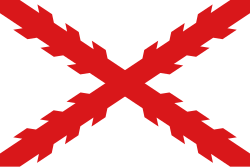
Back إسبانيا هابسبورغ Arabic Casa d'Austria AST Габсбургская Іспанія Byelorussian Хабсбургска Испания Bulgarian Casal d'Àustria Catalan Habsburské Španělsko Czech Habsburg-Spanien Danish Ισπανία των Αψβούργων Greek Casa de Austria Spanish Habsburgide Hispaania Estonian
Monarquía de España | |||||||||||||||||
|---|---|---|---|---|---|---|---|---|---|---|---|---|---|---|---|---|---|
| 1516–1700 | |||||||||||||||||
 1570 map of the Iberian Peninsula | |||||||||||||||||
| Capital | Madrid (1561–1601; 1606–1700) Valladolid (1601–1606) | ||||||||||||||||
| Official languages | Spanish | ||||||||||||||||
| Religion | Catholicism | ||||||||||||||||
| Demonym(s) | Spaniard, Spanish | ||||||||||||||||
| Government | Composite monarchy | ||||||||||||||||
| Monarch | |||||||||||||||||
• 1516–1556 (first) | Charles I | ||||||||||||||||
• 1665–1700 (last) | Charles II | ||||||||||||||||
| Legislature | Cortes of Castile Courts of Aragon Courts of Catalonia Courts of Valencia Cortes of Navarre Cortes of Portugal | ||||||||||||||||
| Historical era | Early modern period | ||||||||||||||||
• Ascension of Charles I | 23 January 1516 | ||||||||||||||||
| 1568–1648 | |||||||||||||||||
| 1580–1640 | |||||||||||||||||
| 1635–1659 | |||||||||||||||||
| 1640–1668 | |||||||||||||||||
• Death of Charles II | 1 November 1700 | ||||||||||||||||
| Currency | Spanish real and others | ||||||||||||||||
| |||||||||||||||||
| Today part of | Spain | ||||||||||||||||
| History of Spain |
|---|
 18th century map of Iberia |
| Timeline |
Habsburg Spain[b] refers to Spain and the Hispanic Monarchy, also known as the Catholic Monarchy, in the period from 1516 to 1700 when it was ruled by kings from the House of Habsburg. In this period the Spanish Empire was at the zenith of its influence and power. During this period, Spain held many territories, including American continental holdings and the West Indies; European territories like the Low Countries, Italian territories, Portugal and parts of France; and the Philippines and other possessions in Southeast Asia. The period of Spanish history has also been referred to as the "Age of Expansion".
The Habsburg name was not always used by the family members, who often emphasized their more prestigious princely titles. The dynasty was long known as the "House of Austria". In some circumstances, the family members were identified by their birthplace. Thus, Charles V was known in his youth as Charles of Ghent. As king of Spain, he was known as Charles I of Spain and as emperor, Charles V (in French, Charles Quint). In Spain, the dynasty was known as the Casa de Austria, including illegitimate sons such as John of Austria and John Joseph of Austria. The arms displayed in their simplest form were those of Austria, which the Habsburgs had made their own, at times impaled with the arms of the Duchy of Burgundy (ancient), as seen on the arms of John of Austria. Calling this era "Habsburg", is, to some extent, a convenience for historians.
The marriage of Isabella I of Castile and Ferdinand II of Aragon in 1469 united the two main crowns, Castile and Aragon, which eventually led to the de facto unification of Spain after the culmination of the Reconquista with the conquest of Granada in 1492 and of Navarre from 1512 to 1529. Isabella and Ferdinand were given the title of "Catholic Monarchs of Spain" by Pope Alexander VI in 1494.[3] With the Habsburgs, the term Monarchia Catholica (Catholic Monarchy, Modern Spanish: Monarquía Católica) remained in use. Spain remained one of the greatest political and military powers in Europe and the world for much of the 16th and 17th centuries. The Habsburg period ushered in the Spanish Golden Age of arts and literature, producing some of the world's most influential writers, painters, and intellectuals, including Teresa of Ávila, Pedro Calderón de la Barca, Miguel de Cervantes, Francisco de Quevedo, Diego Velázquez, El Greco, Domingo de Soto, Francisco Suárez and Francisco de Vitoria. The death of Charles II, the last Habsburg king of Spain, in 1700, led to the War of the Spanish Succession and the ascension of Philip V of the Bourbon dynasty.
- ^ Monarchia Hispanica.google.com, Monarchia Hispaniae. digital.ub.uni.
- ^ Reyno de España, google.com
- ^ Kamen, H. (2005). Spain 1469–1714: A Society of Conflict. Routledge:Oxford. p. 37.
{{cite book}}: CS1 maint: publisher location (link)
Cite error: There are <ref group=lower-alpha> tags or {{efn}} templates on this page, but the references will not show without a {{reflist|group=lower-alpha}} template or {{notelist}} template (see the help page).
© MMXXIII Rich X Search. We shall prevail. All rights reserved. Rich X Search

